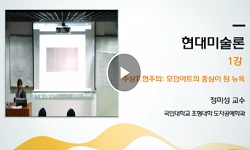In the art, Minimalism which belongs to Postmodernism affected over all world of art starting at 70's with American art. Since World War Ⅱ, the overall American art world had rejected Modernism and the experimental avant garde-oriented Postmodernism...
http://chineseinput.net/에서 pinyin(병음)방식으로 중국어를 변환할 수 있습니다.
변환된 중국어를 복사하여 사용하시면 됩니다.
- 中文 을 입력하시려면 zhongwen을 입력하시고 space를누르시면됩니다.
- 北京 을 입력하시려면 beijing을 입력하시고 space를 누르시면 됩니다.
https://www.riss.kr/link?id=T11008968
- 저자
-
발행사항
대전 : 충남대학교 대학원, 2006
-
학위논문사항
학위논문(석사) -- 충남대학교 대학원 , 무용학과 무용학전공 , 2006. 8
-
발행연도
2006
-
작성언어
한국어
-
주제어
현대춤 ; 미니멀리즘 ; Minimalism
-
KDC
685.1 판사항(4)
-
발행국(도시)
대전
-
형태사항
ii, 84p. ; 26cm
-
일반주기명
참고문헌: p. 77-80
-
소장기관
-
0
상세조회 -
0
다운로드
부가정보
다국어 초록 (Multilingual Abstract)
In the art, Minimalism which belongs to Postmodernism affected over all world of art starting at 70's with American art. Since World War Ⅱ, the overall American art world had rejected Modernism and the experimental avant garde-oriented Postmodernism became the main stream. Likewise, in the dance art, there were rejection movement against Modernism dance, so the Postmodernism dance was created in this trend.
The minimalist dance of postmodern dance eliminated, minimized and rejected the abstract and decorative expressions, and it also tried essential approach to accommodate ordinary movements and finally established the language of dance.
Since 80's, being affected by American postmodernism, Korean dance also started showing the trend of minimalism. Therefore, this thesis is to study the minimalism relevance of Korean modern dance and to analyze the characteristics of dance art. To do so, the eight art works from 'The 8th Young Dancers' Invitation Performance Chosen by Critics of 2005' were reviewed and the results of analysing minimalism characteristics are following.
Except 「溫故而知新(ONGOIJISIN)」 by In Ju Park, the rest of eight art works have minimalism characteristics on the subjects, movements, stage settings and costumes. From this study, this thesis derived minimalism characteristics from the Korean modern dance as follows.
First, the minimalism characteristics of subject aspects of 「who Is Afraid of Grasping a Harpoon?」 by Hae Jun Lee and 「My Sky」 by Young Doo Jung are mainly expressed momentary situations from political background and movement itself.
Secondly, when it comes to the minimalism characteristics from 「The Viewpoint」 by Jung A Kim, 「Angular Velocit」 by Tae Sang Lee and 「My Sky」 by Young Doo Jung, the techniques of restraining, eliminating and minimizing the artificial elements are used, so it could maximize their dance language and the movement to express the subjects.
Thirdly, the minimalism characteristics of stage settings and properties on 「Who Is Afraid of Grasping a Harpoon?」 by Hae Jun Lee and 「Angular Velocit」 by Tae Sang Lee are mainly the elimination or minimization of decorative elements to emphasize various movements.
Forthly, this thesis examined the costumes of 「About Three Airs」 by Na Hoon Park, 「Who Is Afraid of Grasping a Harpoon?」 by Hae Jun Lee, 「The Viewpoint」 by Jung A Kim, 「Intimate Distance」 by Jung Min Yoon, 「Angular Velocit」 by Tae Sang Lee, 「Don't worship other gods」 by Jung Eun Kim and 「My Sky」 by Young Doo Jung. The design of costumes are simplified to use the primary colors like black and white. As our body became concerned, to have comfortable movements, the restrained and simplified design are preferred rather than the decorative and dragged one.
From the results of analyzing the eight artworks of 'The 8th Young Dancers' Invitation Performance Chosen by Critics of 2005', this thesis shows that the minimalism characteristics on the Korean dance are the movements and techniques like restraining, eliminating and minimizing to express choreographers' intentions. The minimalism characteristics among Korean fictive arts' tendency are developed basing on symbolism and abstractness which dance art has. Because movements on the stage are focused rather background, it is considered that choreographers' movements development are stimulated through minimizing the stage settings.
However, the vagueness and ambiguity of minimalism can trigger other kinds of communication problems, so it is hard to avoid critics. Using the Tanztheater style on the current Korean modern dance could be pointed out as a negative aspect of minimalism effects.
Like above, the techniques of developing movements could be urgent matters to have positive effects from the artistic trend of minimalism, and it is required to educate choreographers to realize a thread connection between his or her artistic intention and movements, namely the essence of dance.
목차 (Table of Contents)
- 목차 = ⅰ
- Ⅰ. 서론 = 1
- 1. 연구의 필요성 및 목적 = 1
- 2. 연구의 방법 및 제한점 = 3
- Ⅱ. 이론적 배경 = 7
- 목차 = ⅰ
- Ⅰ. 서론 = 1
- 1. 연구의 필요성 및 목적 = 1
- 2. 연구의 방법 및 제한점 = 3
- Ⅱ. 이론적 배경 = 7
- 1. 미니멀리즘의 개념 및 탄생 배경 = 7
- 2. 미니멀리즘 예술의 전개양상 = 12
- 3. 미니멀리즘과 무용예술의 연관성 = 17
- Ⅲ. 한국 현대 춤의 미니멀리즘 경향 분석 = 25
- 1. 박나훈의 「세 개의 공기」 = 25
- 2. 박인주의 「溫故而知新」 = 31
- 3. 이해준의 「누가 혹시 작살 잡는 것을 두려워하나」 = 36
- 4. 김정아의 「그림자의 시선」 = 41
- 5. 윤정민의 「스킨쉽」 = 45
- 6. 이태상의 「각속도」 = 49
- 7. 김정은의 「다른 신을 섬기지 말라」 = 54
- 8. 정영두의 「내가 가진 하늘」 = 59
- Ⅳ. 한국 현대 춤에 나타난 미니멀리즘적 특성 = 65
- Ⅴ. 결론 = 73
- 참고문헌 = 77
- ABSTRACT = 81







